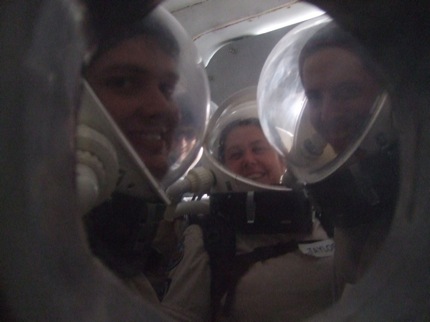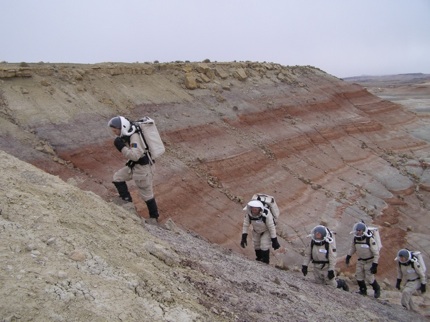Mars Surface Report #2
The following is part two of a series of five emails I sent to a local middle school during my visit to the Mars Desert Research Station as the crew geologist.
Hello again,
What an amazing two days! If anything can go wrong, it definitely will. Engineers are incredibly important to have around on space trips. Our team has electrical engineers (for wires and electricity) and mechanical engineers (for everything else), and between them they’re able to fix just about anything, Plumbing problems, generators, changing the oil in {en:ATV}s, fixing spacesuits, getting the hot water tank running, pump fresh water for us to drink, and everything in between. Without them we wouldn’t have heat, electricity, or water. In fact, engineers are really important in the {en:NASA} space program too. On the {en:International Space Station} they have to fix things just like we do, without any extra tools or equipment apart from what they take with them.
Only the heating hasn’t died yet on our mission, but we’ve certainly had our share of problems. Last night we lost power four times, and tonight three times. It’s incredibly dark in the {en:desert}, so when the power goes out it’s reeeeeeeally dark. It’s a good idea to always carry a flashlight, I think. Can you imagine what it would be like without heat, water or power? Or all three at once?
Tonight the power generator is down so we’re operating on battery backup right now. Hopefully the power will stay up long enough for me to send this email to you. We don’t need a lot of electricity though, and our engineers will fix it tomorrow.
I wanted to show you some pictures of what it looks like when we go onto the surface of “Mars”. The rocks and scenery here are amazing! Our spacesuits don’t work the same way as real spacesuits, but they’reclose. They give us air so we can breath inside the helmets, a radio so we can talk to our crewmembers standing beside us (otherwise they can’t hear you), and protection against the cold. It was 3°C outside today, but I was perfectly warm inside my suit.

When we go outside in spacesuits we call it an “EVA,” which stands for Extra-Vehicular Activity. Lately we’ve been going on EVAs just to get used to wearing and walking in the suits. It’s sometimes cramped and the backpacks that keep us alive are heavy, so they take some getting used to. I usually turn my radio up too loud by accident before I go into the airlock, and once I’m outside I can’t change the volume. All my radio calls are then really loud, but there’s nothing I can do once I’m outside. Also, there’s no way to scratch an itch on your face because the helmet is in the way. The best thing you can do is to try not to think about it, and look at what it’s like to pretend to be on Mars.
Have you looked up at night sky lately? Mars is the reddish twinkling star near the the two brightest stars to the East. It will take a LOT of scientists and engineers and other helpers to get there one day. Many of these people are in school right now, maybe even in middle school. Spaceships have to be built, tools have to be made, experiments have to be done, spacesuits need to be made better, and food needs to be healthier. Are you up to the challenge?

Next time I’ll talk about the sort of food we eat and show you some pictures of astronauts doing real work on the surface. Digging, getting tired, digging some more, and driving on ATVs.
We also do field trips here — the man standing outside without a spacesuit is on one of these trips. Look at his feet, those are all shells from animals that lived over 100 million years ago.
Kerry
Crew Geologist
Crew 66 – Mars Desert Research Station


